The Activation of Mg Powder Promoted by Chloride and Activation Mechanism
Abstract
:1. Introduction
2. Experimental
2.1. Material Preparation
2.2. Hydrolysis Experiment
2.3. Characterization Tests
3. Results
3.1. Characterization of Active Mg
3.2. The Hydrolysis Properties of Active Mg with Different Chlorides
3.2.1. Hydrogen Generation Property
3.2.2. The Characteristics of Hydrolysis Products
4. Discussions
4.1. The Different Activation Effects of Different Chlorides
4.2. The Effects of Co on the Activation of Mg Powder
4.3. The Evolutions during Ball Milling Mg with CoCl2
4.3.1. The Morphology Change of Mg Powder after Ball Milling with CoCl2
4.3.2. The Evolution of Co2+ during Ball Milling Mg with CoCl2
4.4. The Activation Mechanism
- 1.
- Ball milling effect—The large number of cracks generated as the Mg powder with chloride is squashed and overlapped during ball milling. This leads to the exposure of fresh Mg and gives more active positions for Mg-water reaction. In addition, high potential metallics were generated as the reduction reaction occurred during ball milling promotes the corrosion of Mg.
- 2.
- The dual promoting effect of Cl−—The existence of Cl− in the system has two functions: one is acting as electrolyte for the Mg-M galvanic cell which accelerates the corrosion of Mg; the other is as the crystallization promoter, which modified the Mg(OH)2 into self-assembled morphology that easily falls off from the surface of the Mg.
5. Conclusions
Author Contributions
Funding
Institutional Review Board Statement
Informed Consent Statement
Data Availability Statement
Acknowledgments
Conflicts of Interest
References
- Bauen, A. Future energy sources and systems—Acting on climate change and energy security. J. Power Sources 2006, 157, 893–901. [Google Scholar] [CrossRef]
- Broom, D.P.; Webb, C.J.; Hurst, K.E.; Parilla, P.A.; Gennett, T.; Brown, C.M.; Zacharia, R.; Tylianakis, E.; Klontzas, E.; Froudakis, G.E.; et al. Outlook and challenges for hydrogen storage in nanoporous materials. Appl. Phys. A 2016, 122, 151. [Google Scholar] [CrossRef] [Green Version]
- Guillen, C.; Herrero, J. TCO/metal/TCO structures for energy and flexible electronics. Thin Solid Films 2011, 520, 1–17. [Google Scholar] [CrossRef]
- Schapbach, L.; Zuttel, A. Hydrogen-storage materials for mobile applications. Nature 2001, 414, 353–358. [Google Scholar] [CrossRef] [PubMed]
- Fan, M.Q.; Liu, S.S.; Zhang, Y.; Zhang, J.; Sun, L.-X.; Xu, F. Superior hydrogen storage properties of MgH2–10 wt.% TiC composite. Energy 2010, 35, 3417–3421. [Google Scholar] [CrossRef]
- Fan, M.Q.; Sun, L.-X.; Xu, F. Experiment assessment of hydrogen production from activated aluminum alloys in portable generator for fuel cell applications. Energy 2010, 35, 2922–2926. [Google Scholar] [CrossRef]
- Kaur, M.; Pal, K. Review on hydrogen storage materials and methods from an electrochemical viewpoint. J. Energy Storage 2019, 23, 234–249. [Google Scholar] [CrossRef]
- Fukuchi, A.; Kawashima, M.; Yuasa, S. Combustion characteristics of Mg–CO2 counterflow diffusion flames. Symp. Combust. 1996, 26, 1945–1951. [Google Scholar] [CrossRef]
- Shafirovich, E.Y.; Goldshleger, U.I. Combustion of magnesium particles in CO2/CO mixtures. Combust. Sci. Technol. 1992, 84, 33–43. [Google Scholar] [CrossRef]
- Foote, J.; Litchford, R. Powdered magnesium-carbon dioxide combustion for mars propulsion. In Proceedings of the 41st AIAA/ASME/SAE/ASEE Joint Propulsion Conference and Exhibit, Tucson, Arizona, 10–13 July 2005; p. 4469. [Google Scholar]
- Shevtsov, V.I.; Fursov, V.P.; Stesik, L.N. Mechanism for combustion of isolated magnesium particles. Combust. Explos. Shock. Waves 1976, 12, 758–763. [Google Scholar] [CrossRef]
- Mason, J.E. World energy analysis: H2 now or later? Energy Policy 2007, 35, 1315–1329. [Google Scholar] [CrossRef]
- Hou, X.; Wang, Y.; Yang, Y.; Hu, R.; Yang, G.; Feng, L.; Suo, G. Microstructure evolution and controlled hydrolytic hydrogen generation strategy of Mg-rich Mg-Ni-La ternary alloys. Energy 2019, 188, 116081. [Google Scholar] [CrossRef]
- Xiao, F.; Guo, Y.; Yang, R.; Li, J. Hydrogen generation from hydrolysis of activated magnesium/low-melting-point metals alloys. Int. J. Hydrog. Energy 2019, 44, 1366–1373. [Google Scholar] [CrossRef]
- Gupta, R.B. Hydrogen Fuel: Production, Transport, and Storage, 1st ed.; CRC Press: Boca Raton, FL, USA, 2009. [Google Scholar]
- Macanás, J.; Soler, L.; Candela, A.M.; Muñoz, M.; Casado, J. Hydrogen generation by aluminum corrosion in aqueous alkaline solutions of inorganic promoters: The AlHidrox process. Energy 2011, 36, 2493–2501. [Google Scholar] [CrossRef]
- Parmuzina, A.V.; Kravchenko, O.V. Activation of aluminium metal to evolve hydrogen from water. Int. J. Hydrog. Energy 2008, 33, 3073–3076. [Google Scholar] [CrossRef]
- Kushch, S.D.; Kuyunko, N.S.; Nazarov, R.S.; Tarasov, B.P. Hydrogen-generating compositions based on magnesium. Int. J. Hydrog. Energy 2011, 36, 1321–1325. [Google Scholar] [CrossRef]
- Grosjean, M.H.; Zidoune, M.; Roué, L. Hydrogen production from highly corroding Mg-based materials elaborated by ball milling. J. Alloy. Compd. 2005, 404–406, 712–715. [Google Scholar] [CrossRef]
- Grosjean, M.H.; Zidoune, M.; Roué, L.; Huot, J.Y. Hydrogen production via hydrolysis reaction from ball-milled Mg-based materials. Int. J. Hydrog. Energy 2006, 31, 109–119. [Google Scholar] [CrossRef]
- Huang, M.; Ouyang, L.; Ye, J.; Liu, J.; Yao, X.; Wang, H.; Shao, H.; Zhu, M. Hydrogen generation via hydrolysis of magnesium with seawater using Mo, MoO2, MoO3 and MoS2 as catalysts. J. Mater. Chem. A 2017, 5, 8566–8575. [Google Scholar] [CrossRef]
- Huang, H.T.; Zou, M.S.; Guo, X.Y.; Yang, R.J.; Li, Y.K. Study of reactions of activated Mg-based powders in heated steam. J. Power Sources 2014, 246, 960–964. [Google Scholar] [CrossRef]
- Zou, M.; Guo, X.; Huang, H. Preparation and characterization of hydro-reactive Mg–Al mechanical alloy materials for hydrogen production in seawater. J. Power Sources 2012, 219, 60–64. [Google Scholar] [CrossRef]
- Matsuzaki, K.; Murakami, T. Formation of Hydrogen by Ball Milling of Mg and Mg Alloy in Seawater. Mater. Sci. Forum 2017, 879, 1265–1269. [Google Scholar] [CrossRef]
- Kravchenko, O.V.; Sevastyanova, L.G.; Urvanov, S.A.; Bulychev, B.M. Formation of hydrogen from oxidation of Mg, Mg alloys and mixture with Ni, Co, Cu and Fe in aqueous salt solutions. Int. J. Hydrog. Energy 2014, 39, 5522–5527. [Google Scholar] [CrossRef]
- Liu, Y.; Wang, X.; Dong, Z.; Liu, H.; Li, S.; Ge, H.; Yan, M. Hydrogen generation from the hydrolysis of Mg powder ball-milled with AlCl3. Energy 2013, 53, 147–152. [Google Scholar] [CrossRef]
- Wang, X.; Zhang, Q.; Shi, X.; Wang, N.; Chai, Y. Synergistic effect of the fresh Co, Ni, and anion ions on aluminum or magnesium with water reactions. Int. J. Energy Res. 2019, 43, 430–438. [Google Scholar] [CrossRef] [Green Version]
- Sun, Q.; Zou, M.; Guo, X.; Yang, R.; Huang, H.; Huang, P.; He, X. A study of hydrogen generation by reaction of an activated Mg–CoCl2 (magnesium–cobalt chloride) composite with pure water for portable applications. Energy 2015, 79, 310–314. [Google Scholar] [CrossRef]
- Song, X.; Sun, S.; Zhang, D.; Wang, J.; Yu, J. Synthesis and characterization of magnesium hydroxide by batch reaction crystallization. Front. Chem. Sci. Eng. 2011, 5, 416–421. [Google Scholar] [CrossRef]
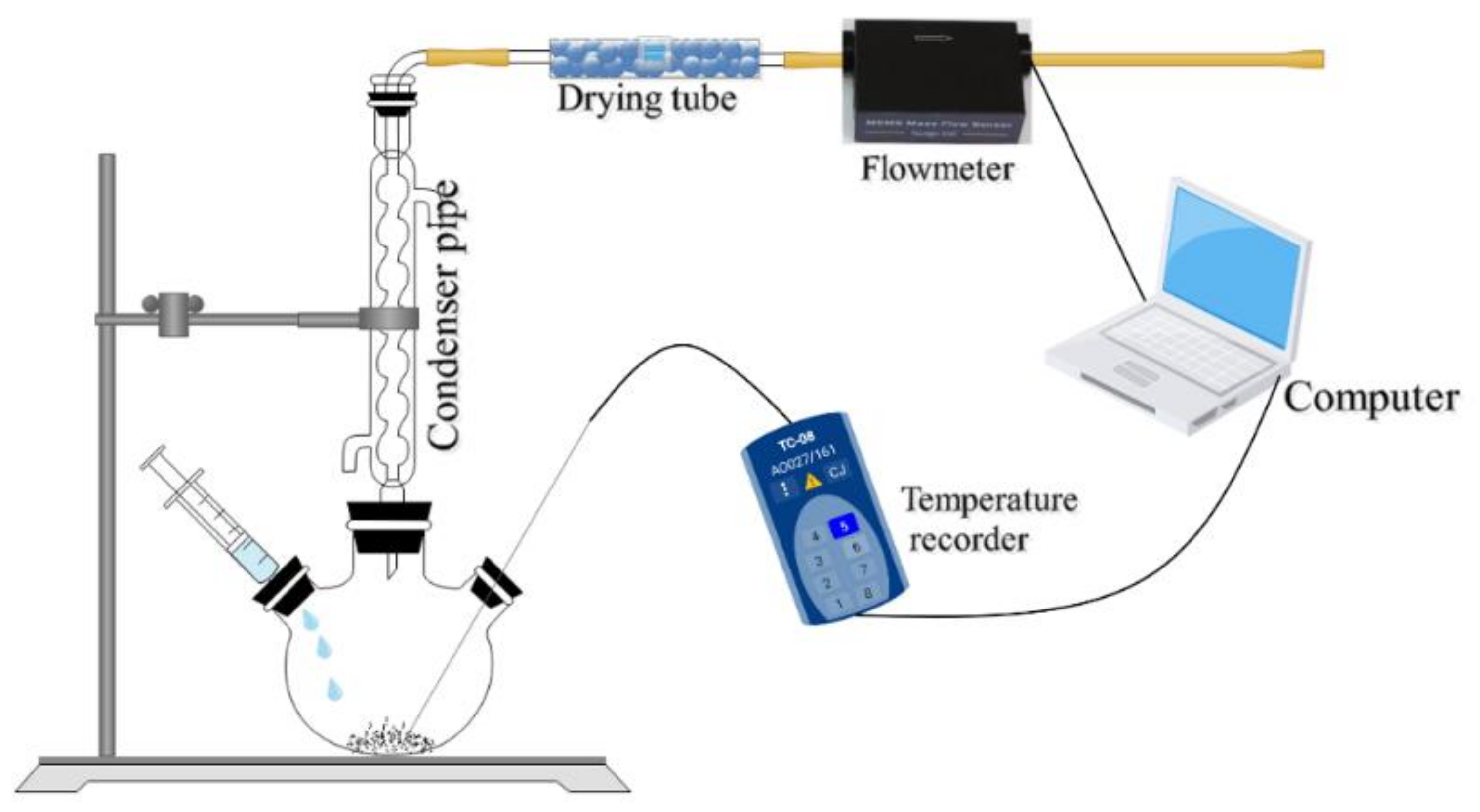

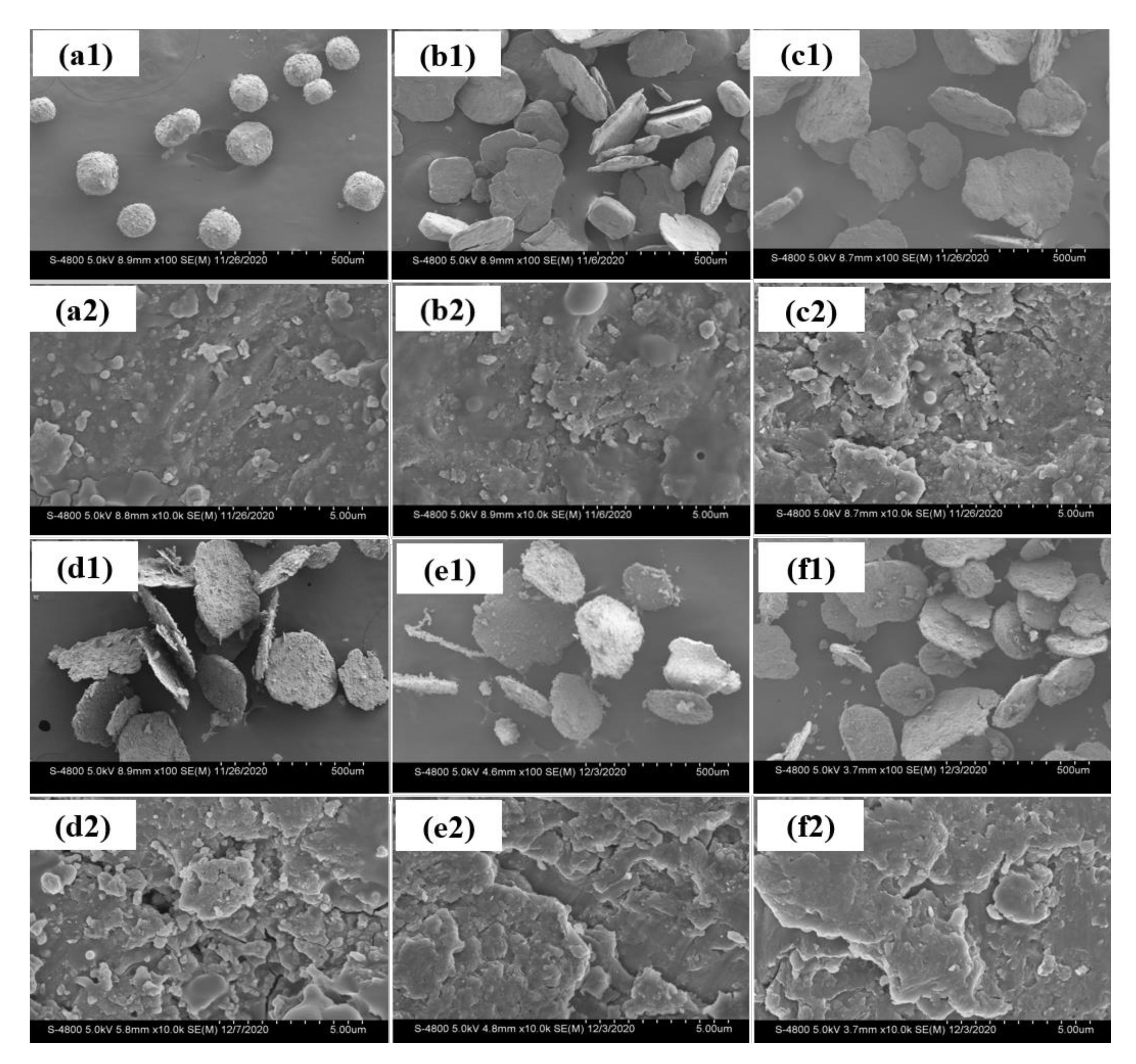
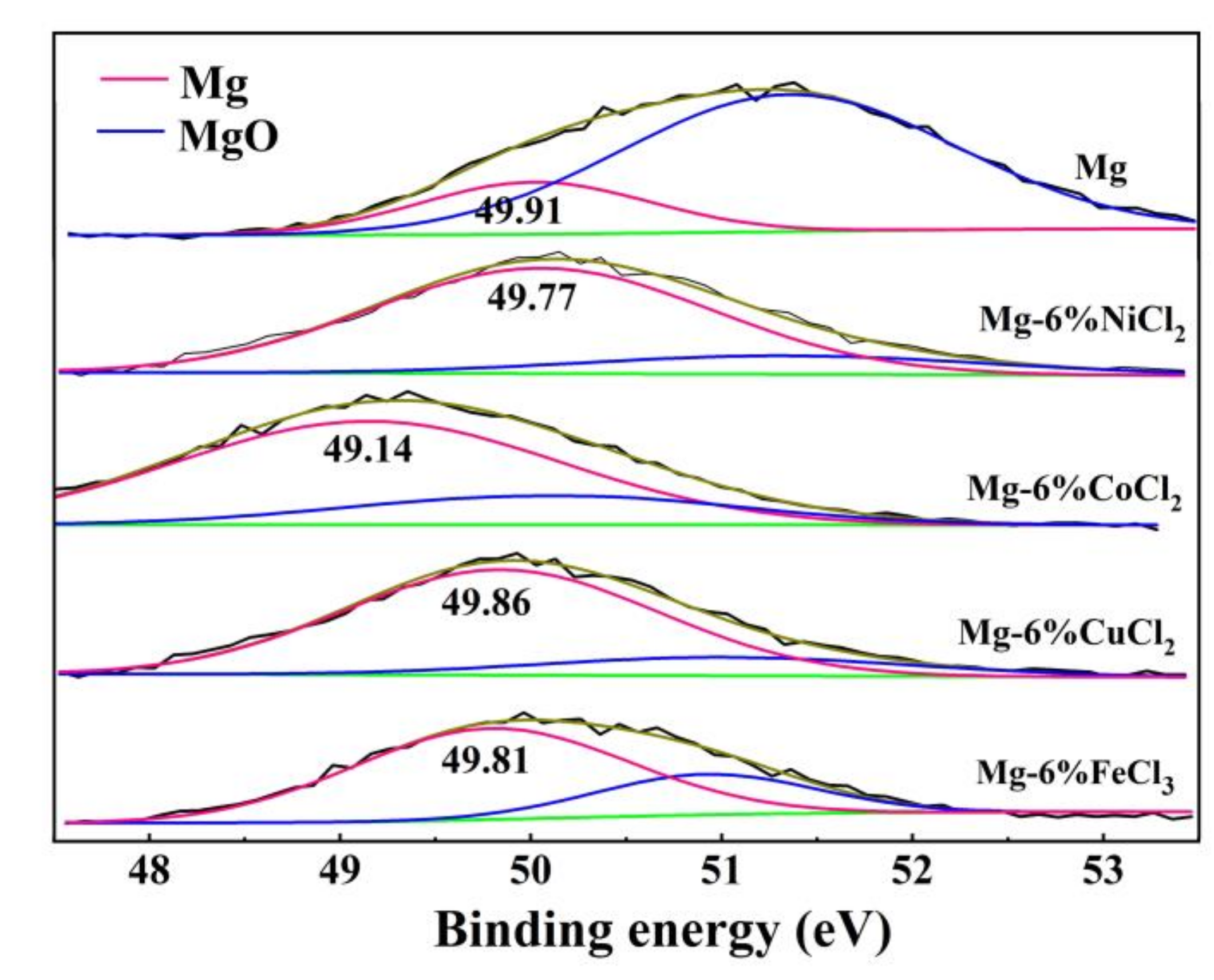


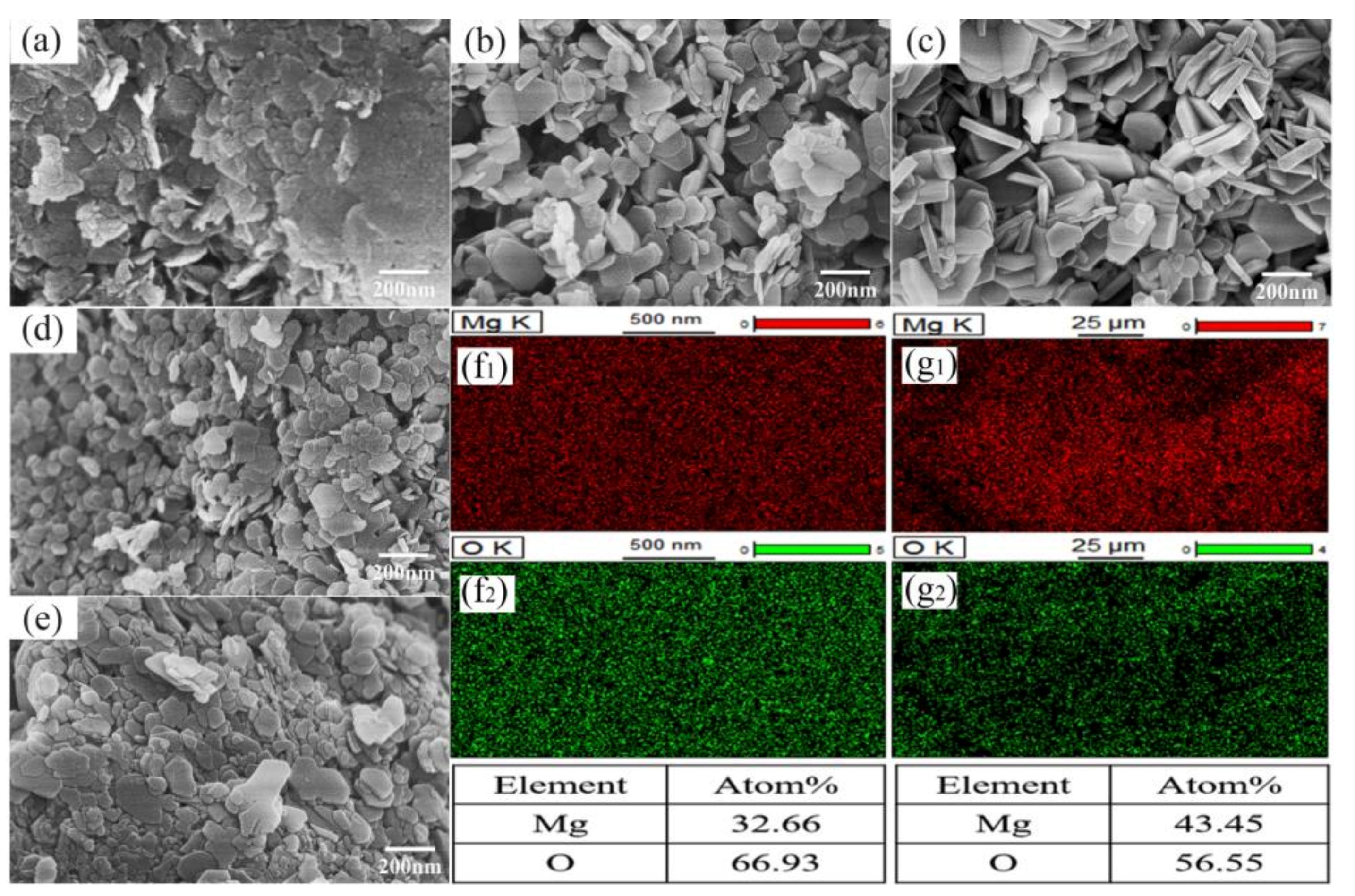
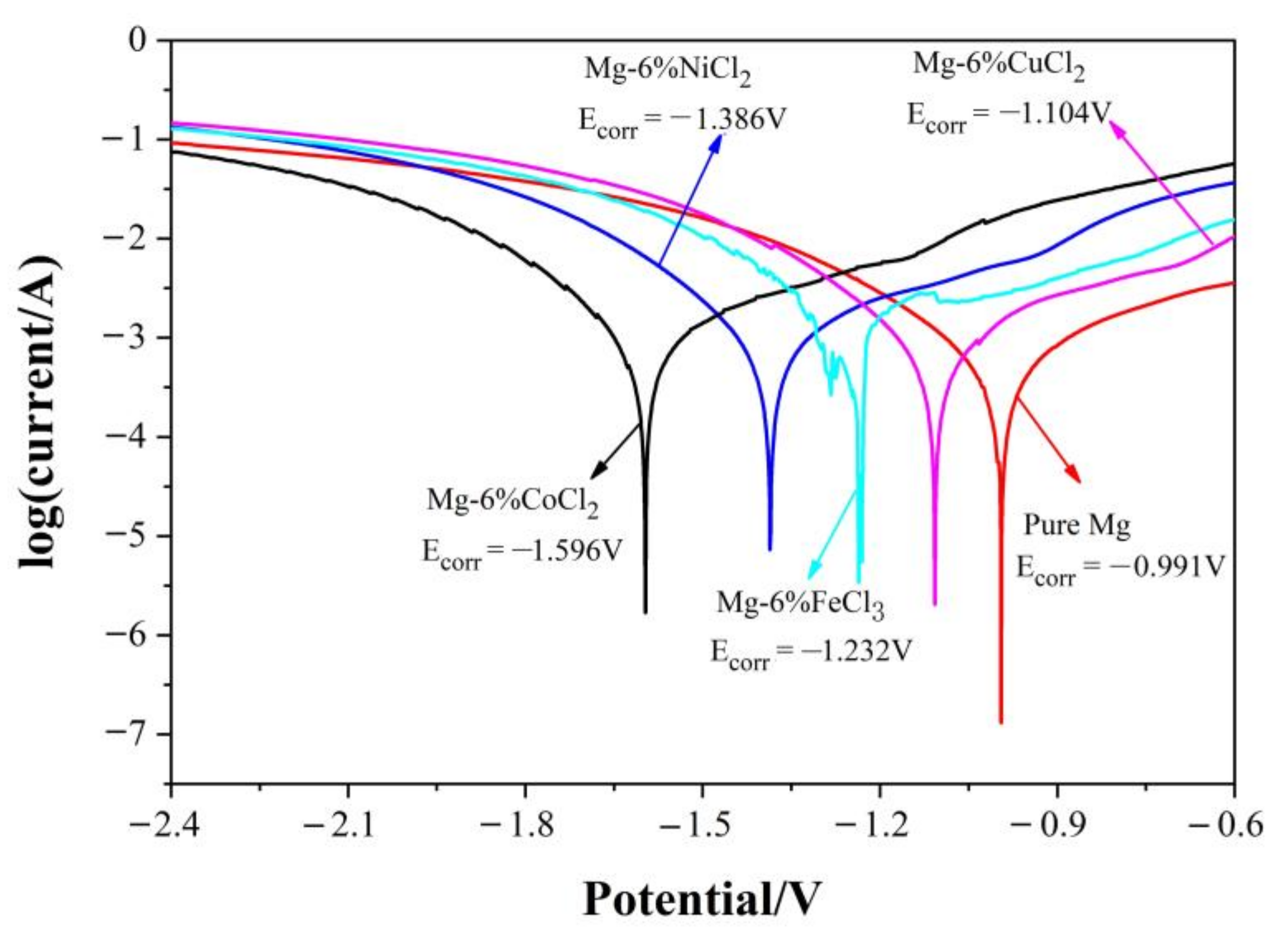




| Ball Milling | Parameters |
|---|---|
| Milling balls | Steel ball; diameter: 5 mm |
| Ball milling speed | 500 r/min |
| Ball milling atmosphere | Argon |
| Ball milling time | 3 h |
| Ball/material mass ratio | 40:1 |
| Sample (0.5 g) | Hydrogen Generation Volume (L) | Conversion Yield (%) | Maximum Hydrogen Generation Rate (L·min−1) | Reaction Duration (s) |
|---|---|---|---|---|
| Mg | 0.002 | 4.28 | 0.001 | 5 |
| Mg-6%NiCl2 | 0.347 | 79.2 | 0.434 | 276 |
| Mg-6%CoCl2 | 0.423 | 96.6 | 0.597 | 325 |
| Mg-6%CuCl2 | 0.141 | 32.2 | 0.153 | 830 |
| Mg-6%FeCl3 | 0.258 | 58.9 | 0.157 | 1684 |
| 0.5 g | Tap Water | NaCl Solute | ||||
|---|---|---|---|---|---|---|
| HGR (L) | Conversion Yield (%) | MHGR (L·min−1) | HGR (L) | Conversion Yield (%) | MHGR (L·min−1) | |
| Mg | 0.000 | 0.0 | 0.000 | 0.108 | 23.1 | 0.132 |
| Mg-6%Co | 0.000 | 0.0 | 0.000 | 0.421 | 90.1 | 3.001 |
Publisher’s Note: MDPI stays neutral with regard to jurisdictional claims in published maps and institutional affiliations. |
© 2021 by the authors. Licensee MDPI, Basel, Switzerland. This article is an open access article distributed under the terms and conditions of the Creative Commons Attribution (CC BY) license (https://creativecommons.org/licenses/by/4.0/).
Share and Cite
Wang, X.; Guo, X.; Zhu, L.; Wang, S.; Zou, M.; Li, X.; Zhang, X.; Song, T. The Activation of Mg Powder Promoted by Chloride and Activation Mechanism. Metals 2021, 11, 1435. https://doi.org/10.3390/met11091435
Wang X, Guo X, Zhu L, Wang S, Zou M, Li X, Zhang X, Song T. The Activation of Mg Powder Promoted by Chloride and Activation Mechanism. Metals. 2021; 11(9):1435. https://doi.org/10.3390/met11091435
Chicago/Turabian StyleWang, Xiaoxuan, Xiaoyan Guo, Lixiang Zhu, Shuo Wang, Meishuai Zou, Xiaodong Li, Xiaodong Zhang, and Tinglu Song. 2021. "The Activation of Mg Powder Promoted by Chloride and Activation Mechanism" Metals 11, no. 9: 1435. https://doi.org/10.3390/met11091435
APA StyleWang, X., Guo, X., Zhu, L., Wang, S., Zou, M., Li, X., Zhang, X., & Song, T. (2021). The Activation of Mg Powder Promoted by Chloride and Activation Mechanism. Metals, 11(9), 1435. https://doi.org/10.3390/met11091435









